Misir Wat (Ethiopian Spiced Red Lentils)
This post may contain affiliate links. See my disclosure policy.
One of Ethiopia’s most popular vegetarian dishes, this Misir Wat recipe showcases lentils in a way that’s unlike any you’ve had before. The flavor is simply out of this world! Vegetarian-friendly and so delicious that even devout carnivores won’t miss the meat!

It’s been said that the best vegetarian cuisines in the world are Indian and Ethiopian and I can’t disagree. The flavor profiles of both cuisines bring even the blandest ingredients to life with their rich combinations of spices and herbs.
Misir Wat (also Misir Wot) is one such example of a dish that truly excels in the vegetarian realm. A dish featuring red lentils, an abundantly available crop, Misir Wat is a staple dish throughout Ethiopia and one of the most popular vegetarian dishes in Ethiopian restaurants. If you order a mixed combination platter at an Ethiopian restaurant or order vegetarian, misir wat is almost always among the selections.
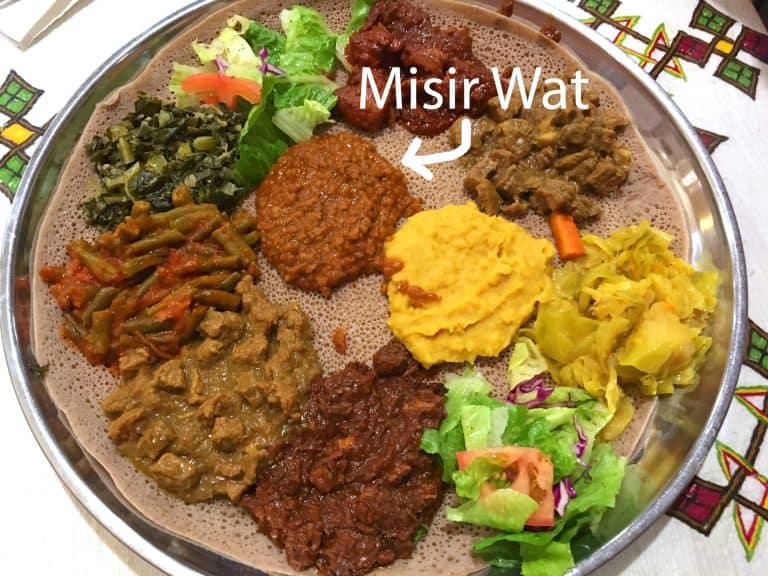
Misir wat starts with onions that are slowly caramelized in niter kibbeh, Ethiopia’s popluar and incredibly flavorful spiced clarified butter. Garlic and tomato paste are added. The comes a generous dose of berbere, Ethiopia’s famous chili seasoning blend. It’s normally fiery-hot (and what you get in Ethiopia is even hotter than what you typically find outside of the country), but our blend tones down the heat and gives you the option of adding it according to your preference.
The lentils are then slow-simmered with these highly aromatic and flavorful ingredients until they’re soft. Another spoonful of niter kibbeh and berbere are added in at the end for an added boost of flavor.
Misir wat is typically served with injera, Ethiopia’s staple fermented flatbread that’s also used as an eating instrument to scoop up the lentils.

Misir Wat Recipe
Let’s get started!
Melt 3 tablespoons of the niter kibbeh in a medium stock pot. Add the onions and cook over medium-high heat for 8-10 minutes until golden brown.
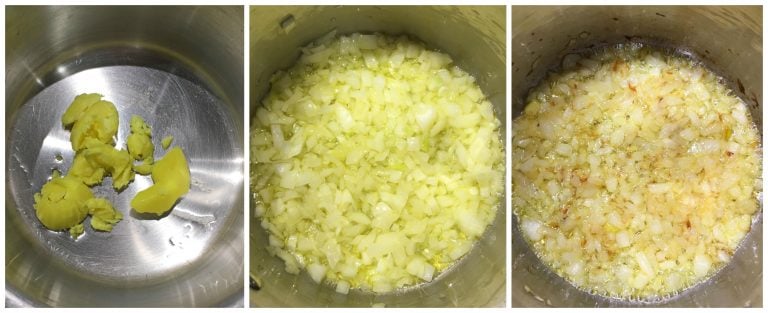
Add the garlic, tomatoes, tomato paste and 1 tablespoon of the berbere and cook for 5-7 minutes. Reduce the heat if needed to prevent burning.
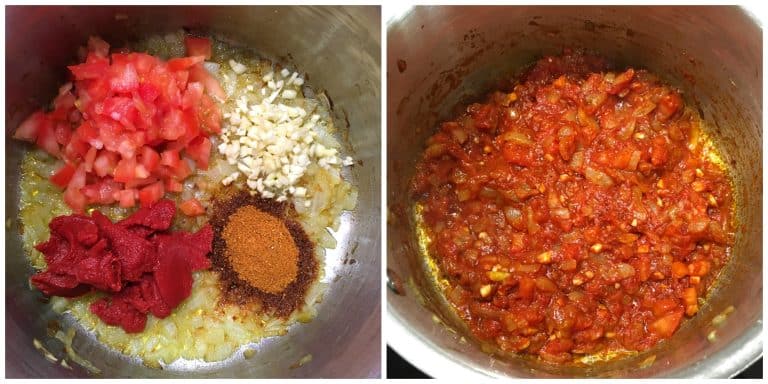
Next we’re adding the broth. As with everything I recommend using the best ingredients you can find and the broth we love and recommend with enthusiasm is Aneto. We visited their factory in Barcelona Spain a year ago and watched the entire broth-making process from start to finish. It was so inspiring! Check out our post about it and take a virtual tour. Aneto selects fresh, free-range chicken and the freshest vegetables and slow-simmer it in gigantic pots for several hours to produce the highest quality broths on the market. No concentrates, powders, artificial ingredients, “natural flavors”, GMO’s, fillers or flavor enhancers of any kind. Just pure, whole, real ingredients. We love and highly recommend Aneto.
For misir wat you can use either chicken broth or if you’re vegetarian, vegetable broth.
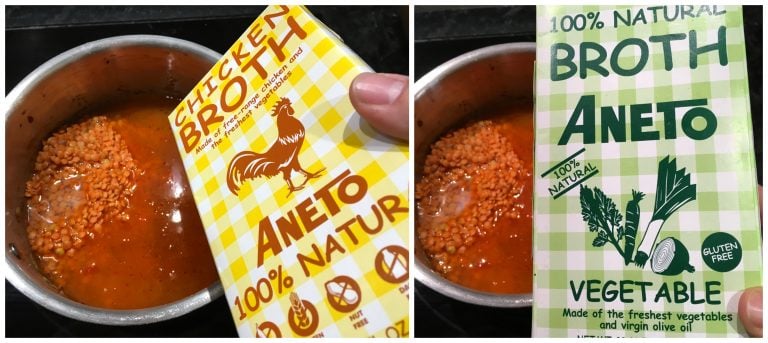
Once you’ve added the broth, salt and lentils, bring it to a boil, reduce the heat to low and cover and simmer the lentils, stirring occasionally, for 40 minutes (adding more broth if needed) or until the lentils are soft.
Stir in the remaining tablespoon of niter kibbeh and berbere. Simmer for a couple more minutes. Add salt to taste.
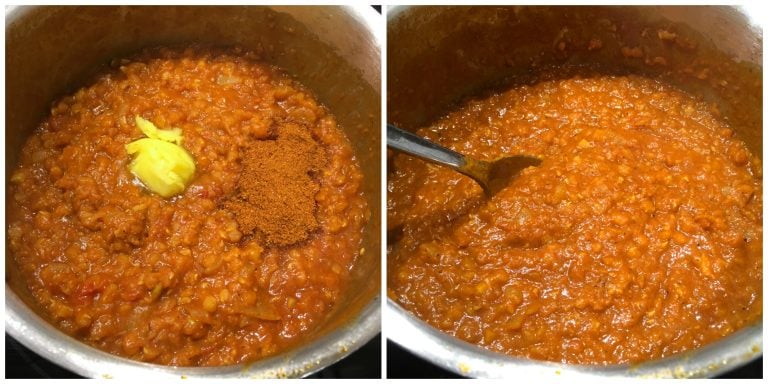
Enjoy!

For more authentic Ethiopian recipes try my:
Save This Recipe

Misir Wat (Ethiopian Spiced Red Lentils)
Ingredients
- 4 tablespoons niter kibbeh , divided
- 1 large yellow onion, very finely diced
- 3 cloves garlic, finely minced
- 1 Roma tomato, very finely chopped
- 3 tablespoons tomato paste
- 2 tablespoons bebere , divided
- Homemade Berbere (strongly recommended)
- 1 cup red lentils, rinsed
- 2 1/2 cups quality chicken broth
- 1 teaspoon salt
Instructions
- Melt 3 tablespoons of the niter kibbeh in a medium stock pot. Add the onions and cook over medium-high heat for 8-10 minutes until golden brown. Add the garlic, tomatoes, tomato paste and 1 tablespoon of the berbere and cook for 5-7 minutes. Reduce the heat if needed to prevent burning.Add the lentils, broth and salt, bring it to a boil, reduce the heat to low and cover and simmer the lentils, stirring occasionally, for 40 minutes (adding more broth if needed) or until the lentils are soft.Stir in the remaining tablespoon of niter kibbeh and berbere. Simmer for a couple more minutes. Add salt to taste.Serve with Ethiopian injera.
Nutrition
Originally published on The Daring Gourmet April 29, 2018



















This was ridiculously, sinfully good. A new keeper in our rotation!
Thank you so much, Matt, I’m happy you enjoyed it, I really love this dish too! <3
hello! do you use split or whole res lentils for this recipe? thanks!
Hi DK, I use split red lentils.
The flavours of this stew are excellent. Unfortunately after cooking for over 80 minutes, my lentils never fully softened up. I even had them soaking in water overnight beforehand to soften them further (and make them more IBS-friendly by drawing some of the sugars out). After some Googling I discovered this is a common issue when you try to cook lentils in water that has salt (or acid) in it. So cooking them in chicken or veg stock, tomatoes, and salt was a mistake. The lentils should be cooked in plain water (or with a little baking soda) first before being added to the pot of aromatics and seasonings when fully cooked or almost cooked. Lesson learned and ingredients wasted I guess.
Hi Chelsea, that is a fully debunked myth that continues to circulate around the internet. The reality is, not only does salt NOT prevent legumes from softening, it actually does the OPPOSITE: sodium helps break down the tough skins during cooking and improves the texture and flavor of legumes, making them creamier and more flavorful. America’s Test Kitchen/Cook’s Illustrated wrote a whole article on this myth as have many other reputable cooking media outlets . The reason legumes don’t soften even after a lengthy cooking time is their age. After a year or two they’ll often stay crunchy in the middle not matter how long you cook them. And unfortunately old beans are all too common because there’s no way of knowing how long they sat in warehouses before they made it to the grocery stores, or how long they’ve sat in the grocery stores. I’m removing your unfair 1 star review because I can assure you that the issue isn’t the recipe, it’s the lentils. And the many other positive reviews further attest to this.
This is so delicious! I made the berbere at home, using approximated ingredients, and we love it. Thanks!
May I inquire about the serving size – is there a measurement (1/2 cup, 5 oz, etc)? I’ve already eaten some of the batch so I can’t measure 1/6 of the recipe, but Hubby is tracking food intake for micronutrients. Help, anyone?
Thank you so much, Megan, I’m happy you made and enjoyed both the berbere and the misir wat! I haven’t measured the serving sizes for the misir wat, but it’s a total of 6 servings.
This is a fantastic recipe Kimberly. We have an award winning Ethiopian restaurant nearby (they have a Michelin star) and my whole family agrees that this is BETTER than what we get there. I also find it helpful when we’re thinking about detoxing or weight loss. I’ll make a pot on a Saturday or Sunday and we’ll eat it over the next few days. I invariably lose weight but I NEVER feel deprived. In fact I crave it. It’s so filling and delicious. Thank you so much for the recipe!
Oh I’m so thrilled to hear that, Chris! I’m delighted that this was a family hit and I really appreciate the feedback, thank you!
Great recipe! I’ve made this about eight times and it’s always great. The most recent time, I experimented with a quick version: put everything except the lentils in a blender (Vitamix), blender until smooth, pour into crock pot, stir in lentils, cook on hi setting for 2 hours until simmering, then turn to lo setting for another few hours. It came out wonderful and flavorful! I always add more store-bought niter kibbeh and a couple extra tablespoons of berbere to really make the flavor pop! I also used a few canned fancy Italian San marzan pomoro tomatoes instead of one fresh Roma, and used sundried tomato instead of paste because I ran out. Much easier than all that stovetop cooking :)
Fantastic, Heather, I’m thrilled that this has become a regular, thank you! And that’s awesome, thank you for sharing your hands-off crock pot version!
this recipe is absolutely delicious and I have no idea what it’s not more widely known in the UK!
Thank you so much, Carrie, I’m thrilled that you enjoyed it! It’s not widely known in the U.S. either and I agree that’s a shame!
Great recipe. A lot of people posting recipes don’t include stock and go for water. Water makes the dish bland.
Thank so much, Ben, I agree and I’m happy you enjoyed it! :)
Super tasty, I just used regular butter with some toasted cumin seeds crushed and added as the butter melts. I also added some red pepper and turnip greens that were laying around and it all fit in great!
Fantastic, Bill, thanks so much for the feedback!
I just want to say that this recipe is a staple in my household, I make the berbere in big batches and this is a huge hit with my family. It’s super easy to make it vegan-friendly too!